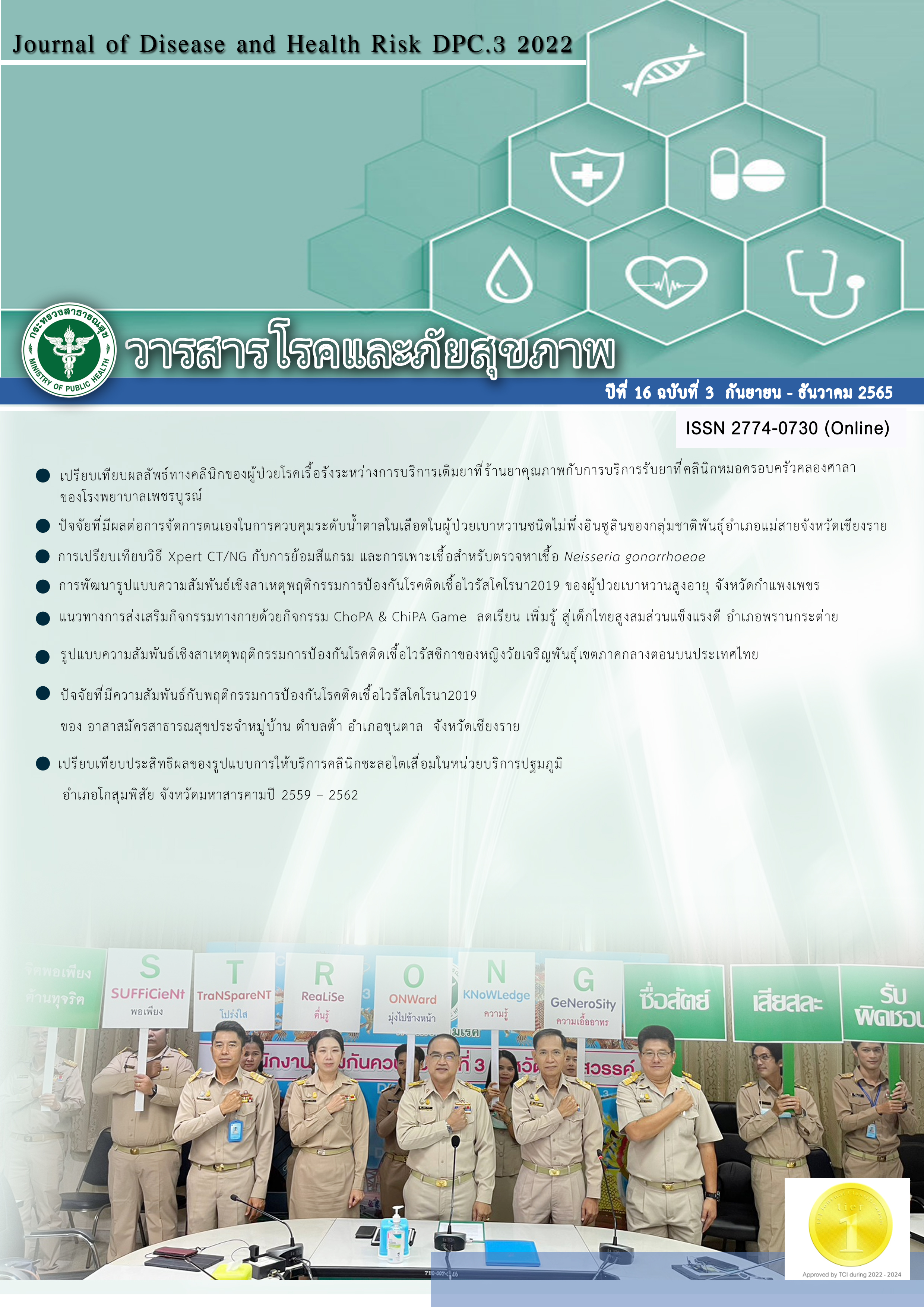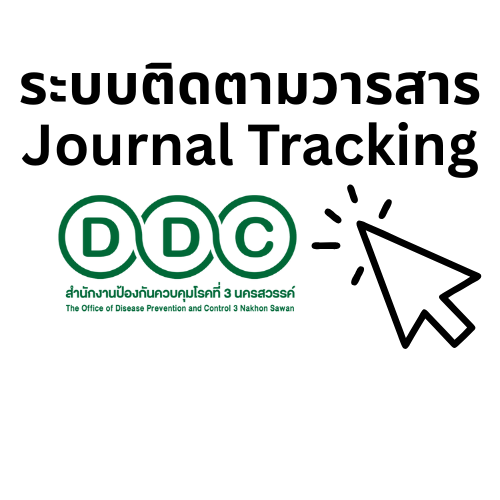Causal Relationship Model of ZIKA Prevention Behavior Among Women of Reproductive Age in Upper Central Region, Thailand
Keywords:
Zika Virus Disease, Prevention Behavior, Reproductive-Age Women, Causal Relationship ModelAbstract
Infection with the Zika virus during pregnancy increases the risk of a baby being born with microcephaly. The aim of the survey was to analyze a model of the causal relationship between Zika screening behavior among women of reproductive age. For the cross-sectional analytical study, 778 women aged 18-49 years in the upper central region of Thailand, including Nakhon Sawan, Kamphaeng, Phet Phichit, Chai Nat and Uthai Thani provinces, were selected through multistage sampling. Data were collected through questionnaires. The latent variables consisted of 1) economic and social status, 2) environmental support and perception of information and 3) health literacy and the dependent variable was Zika prevention behavior. The causal relationship model was analyzed using AMOS. The research findings can be summarized as follows: The model is congruent with evidence-based practice. The observation was based on chi-square=26.31, ϰ2/df =1.05, p-value=0.39. Thus, it is evident that the chi-square value deviated from zero without statistical significance. The weighted values of the factors were in the form of standard scores for the observed variables for the Zika prevention behavior model. Overall, the positive values ranged from 0.18 to 0.92 (p<0.05). The latent variables that directly and indirectly influenced Zika prevention behavior were economic and social status (0.20), environmental support and perception of information (0.12), health literacy (0.04) and economic and social status (0.05). environmental support and perception of information (0.02). All variables were able to contribute 22.0 per cent to explain this model. It can be seen that performance-enhancing Zika prevention among reproductive women could support both the environmental support and perception of information factors and health literacy.
References
Suphamat Phanchai. Congenital infection. Krabi Medical Journal. 2019; 2(1)::49-58.
Mehrjardi MZ. Is Zika Virus an Emerging TORCH Agent? An Invited Commentary. Virology: Research and Treatment. 2017; 8: 1-3. https://doi.org/10.1177/1178122X17708993
Suthipong Pangkanon, Siraporn Sawasdivorn, Chulaluck Kuptanon, Prapasri Kabchan. The Prevalence of Congenital Anomalies in Thailand. THAI JOURNAL OF PEDIATRICS.
; 55(2): 85-92. (in Thai).
Bureau of Emerging Infectious Diseases. Department of Disease Control. Ministry of Public Health. [Internet].2017.[cited 2017 May 16].
Available from: http: // www. Beid.ddc.moph.go.th. (in Thai).
Bureau of Epidemiology, Department of Disease Control, Ministry of Public Health. Surveillance of Zika virus infection.[Internet].2016. [cited 2021 January 10].
Available from: https://bit.ly/3vSPezj (in Thai).
Bureau of Vector-borne Diseases. Department of Disease Control. Ministry of Public Health. [Internet]. 2017.[cited 2017 May 16]. Available from: https://ddc.moph.go.th/ uploads/CKEditor/ 6f4922f45568161a8cdf4 ad2299f6d23/ files/Zika%20Fever /2561/ Zika%2047.pdf. (in Thai).
Office of Disease Prevention and Control 3, Department of Disease Control, Ministry of Public Health.[Internet].2016.[cited 2017 May 16].
Available from:http://odpc3.ddc.moph.go.th/index.php.(in Thai).
Office of Disease Prevention and Control 3, Department of Disease Control, Ministry of Public Health.[Internet]. 2015. [cited 2017 May 16]. Available from: http: //odpc3.ddc.moph. go.th/index.php. (in Thai)
Institute for Population and Social Research, Mahidol University.[Internet].(n.d.).[cited2017 May 16]. Available from: http://www.ipsr. Mahidol.ac.th /ipsrbeta/th/Gazette.aspx. (in Thai).
Office of Health District 3, Ministry of Public Health. [Internet]. 2017. [cited 2017 May 16]. Available from: http://www.spbo3.moph. Go.th/.(in Thai).
Centre for Disease Control. Zika and Pregnant. [Internet]. [cited 2021 January 6]. Available from: https://www.cdc.gov/pregnancy/zika/protect-yourself.html.
World Health Organization. Pregnancy Management in the context of ZIKA Virus Infection, [Internet]. [cited 2021 January 6]. Available from: shorturl.at/efpvT.
Issara Siramaneerat. Perception of the Zika virus infection and its influence on Zika prevention practices by pregnant women at the Region 5 Health Promotion Center in Thailand. Medical Journal of Indonesia. 2018; 27 (3): 201-208.
Kukie Konkeaw, Thitiworada Sangket, Sayamon Phupit. Factors Relating to Zika Virus Prevention Behavior among Pregnant Women in Sai-Ngam District, Kamphaeng Phet Province. Journal of Health Science 2019; 28(2):255-62. (in Thai)
Mouchtouri VA, Papagiannis D, Katsioulis A, Rachiotis G, Dafopoulos K, Hadjichristodoulou C. Knowledge, Attitudes, and Practices about the Prevention of Mosquito Bites and Zika Virus Disease in Pregnant Women in Greece. Int J Environ Res Public Health. 2017;14(4):367. Doi: 10.3390/ijerph14040367. PMID: 28362340; PMCID: PMC5409568.
Heitzinger K, Thoroughman DA, Porter KA. Knowledge, attitudes, and practices of women of childbearing age testing negative for Zika virus in Kentucky, 2016. Prev Med Rep. 2018; 6(10):20-23. Doi: 10.1016/j.pmedr.2018.01.002. PMID: 29868354; PMCID: PMC5984209.
Samuel G, DiBartolo-Cordovano R, Taj I. Merriam A, Lopez JM., Torres C., et al. A survey of the knowledge, attitudes, and practices on Zika virus in New York City.
BMC Public Health. 2018; 18: 98. Available from: https://doi.org/10.1186/s12889-017-4991-3.
National Statistical Office. The number of populations classified by age. [Internet]. (n.d.) [cited 2019 March 15]. Available from: http://stat.dopa.go.th/stat/statnew/upstat_age.php. (in Thai).
Krejcie RV, Morgan DW. Determining Sample Size for Research Activities. Educational and Psychological Measurement, 1970; 30(3): 607-10.
Carlin JB, Hocking J. Design of cross-sectional surveys using cluster sampling: an overview with Australian case studies. Aust N Z J Public Health.; 1999. 23 (5): 546–51.
Nonglak Wiratchai. Structural Relationships(LISREL): Analytical Statistics for Social and Behavioral Science Research. Bangkok. 1995. (in Thai).
Hair JF, Black WC, Babin BJ, Anderson RF. Multivariate Data Analysis. 7th. N.J.: Pearson Practice Hall. 2010.
Sirichai Kanjanawat. Traditional test theory (CLASSICAL TEST THEO RY) (Revised version). Print No. 7. Chulalongkorn University Press: Bangkok. 2013. (in Thai).
Whiteman A, Mejia A, Hernandez I, Loaiza JR. Socioeconomic and demographic predictors of resident knowledge, attitude, and practice regarding arthropod-borne viruses in Panama. BMC Public Health. 2018.14;18(1):1261. Doi: 10.1186/s12889-018-6172-4. PMID: 30428861; PMCID: PMC6236898.
Melo VAD, Silva JRS, La Corte R. Personal protective measures
against Zika virus infection for pregnant women. Rev Saude Publica. 2019;53:72.
Mendoza C, Jaramillo G-I, Ant TH, Power GM, Jones RT, Quintero J, et al. An investigation into the knowledge, perceptions, and role of personal protective technologies in Zika prevention in Colombia. PLoS Negl Trop Dis. 2020;14(1): e0007970. https://doi.org/10.1371/journal.pntd.0007970.
Neeraja C, Mabel M, Sabrina T, Vivek S, Tulay Koru-Sengul, Christine C. Socioeconomic Disparities in Knowledge and Behaviors of Zika virus in Pregnant Women [6J], Obstetrics & Gynecology. 2018; 131: 109S-110S. doi:10.1097/01.AOG.0000533471.93417.4f.
World Health Organization. Pregnancy Management in the context of Zika virus infection. Interim guidance update 13 May 2016. WHO/ZIKA/MOC/16.2 Rev.1 [Internet]. (n.d.) [cited 2019 March 15]. Available from:shorturl.at/uEFGI
Campos MC, Dombrowski JG, Phelan J, Marinho CRF, Hibberd M, Clark TG, et al.
Zika might not be acting alone: Using an ecological study approach to investigate potential co-acting risk factors for an unusual pattern of microcephaly in Brazil. PLoS ONE .2018; 13(8): e0201452. https://doi.org/10.1371/journal.pone.0201452.
Ali S, Gugliemini O, Harber S, Harrison A, Houle L, Ivory J, et al. Environmental and
Social Change Drive the Explosive Emergence of Zika Virus in the Americas. PLoS Negl Trop Dis 2017; 11 (2): e0005135. doi:10.1371/journal.pntd.0005135.
Nelson EJ, Luetke MC, Kianersi S, Willis E, Rosenberg M. Knowledge and perceptions of Zika virus transmission in Puerto Plata, Dominican Republic community. BMC Infectious Diseases. 2019; 19:339. 019) 19:339.https://doi.org/10.1186/s12879-019-3952-0.
Maharajan MK, Rajiah K, Belotindos J-AS, Basa MS. Social Determinants Predicting the Knowledge, Attitudes, and Practices of Women Toward Zika Virus Infection.Front. Public Health. 2020; 8:170. DOI: 10.3389/fpubh.2020.00170.
Berkman ND, Davis TC, McCormack L. Health literacy: What is it? Journal of Health Communication. 2010 ; 15(2): 9-19.
U.S. Department of Health and Human Services, Office of Disease Prevention and Health Promotion. Secretary’s advisory committee on national health promotion and disease prevention objectives for 2030: HEALTH LITERACY. Retrieved from:https://www.healthypeople.gov/sites/default /files/HP2030_Committee-Combined-Issue%20Briefs_2019-508c.pdf.
Thompson EL, Vamos CA, Liggett LG,Griner SB, Ellen M. Daley EM. Using a Health Literacy Analytic Framework to Explore Zika Virus and Reproductive Health. HLRP: Health Literacy Research and Practice. 2018; 2 (2): e79-87.
Maricic M, Stojanovic G, Pazun V, Stepovic M, Djordjevic O, Macuzic IZ, ´et al. Relationship Between Socio-Demographic Characteristics, Reproductive Health Behaviors, and Health Literacy of Women in Serbia. Front. Public Health. 2021; (9): 629051. doi:10.3389/fpubh.2021.629051.
Downloads
Published
How to Cite
Issue
Section
License
Copyright (c) 2022 Journal of Disease and Health Risk DPC.3

This work is licensed under a Creative Commons Attribution-NonCommercial-NoDerivatives 4.0 International License.
Copyright notice
Article published in the Journal of Disease and Health Risk DPC.3 Nakhon Sawan. It is considered a work of academic research and analysis as well as the personal opinion of the author. It is not the opinion of the Office of Disease Prevention and Control 3, Nakhon Sawan. Or the editorial team in any way Authors are responsible for their articles.
Privacy Policy
Name, address and e-mail address specified in the Journal of Disease and Health Risk DPC.3 Nakhon Sawan. It is used for identification purposes of the journal. And will not be used for any other purpose. Or to another person.









